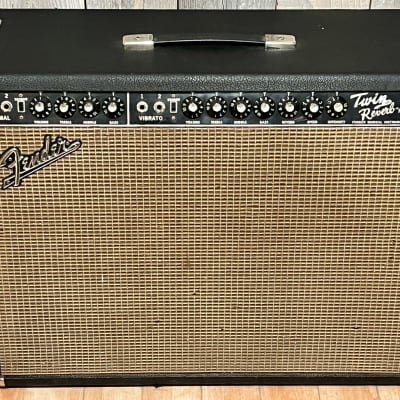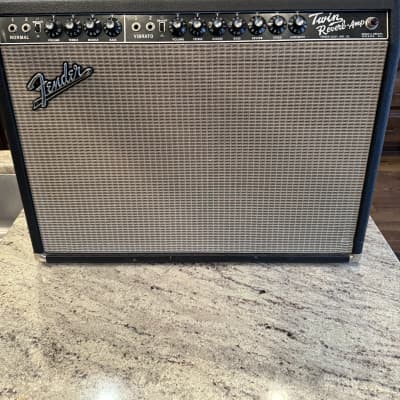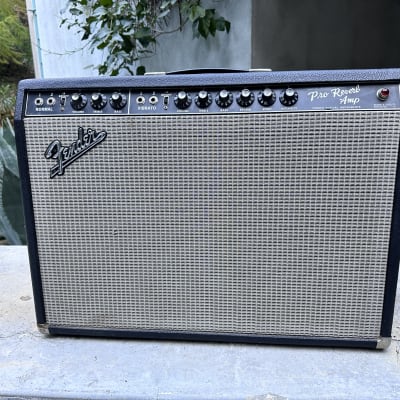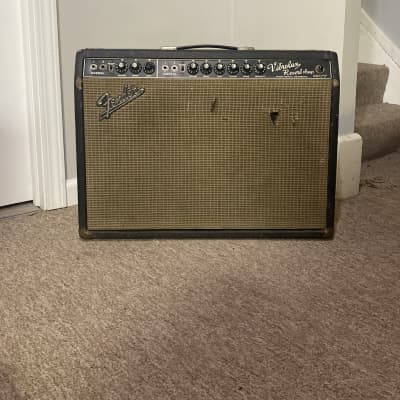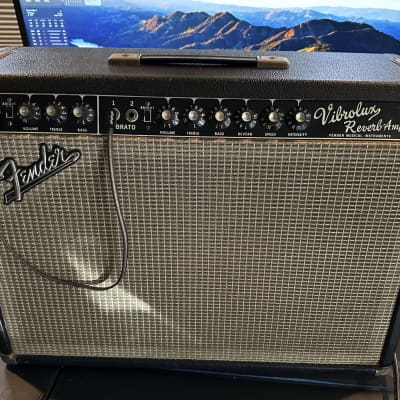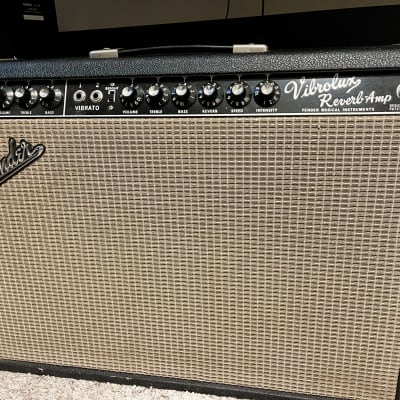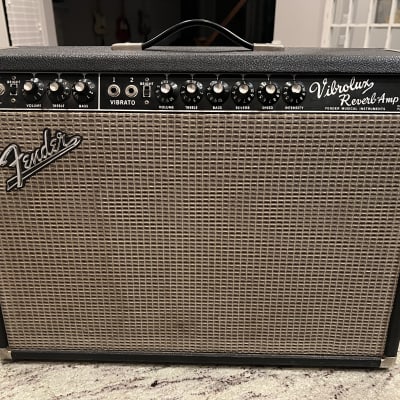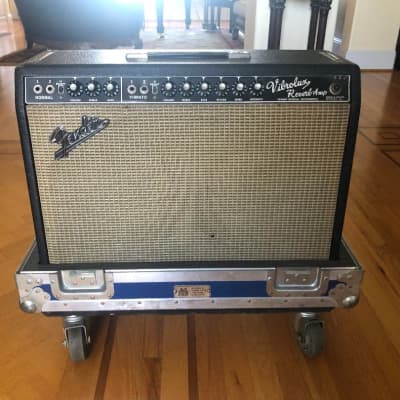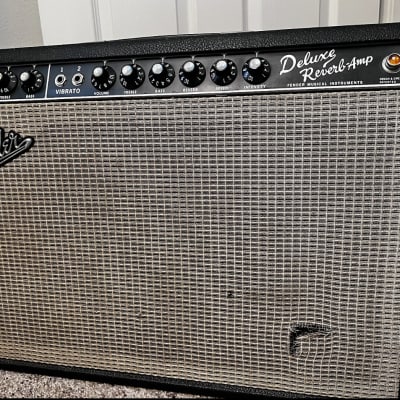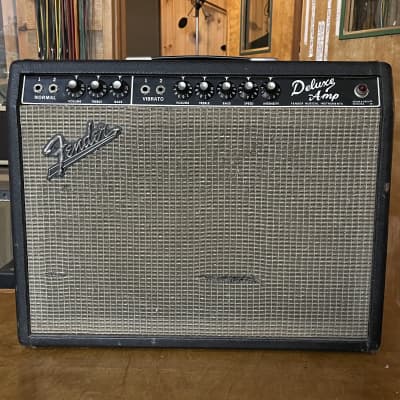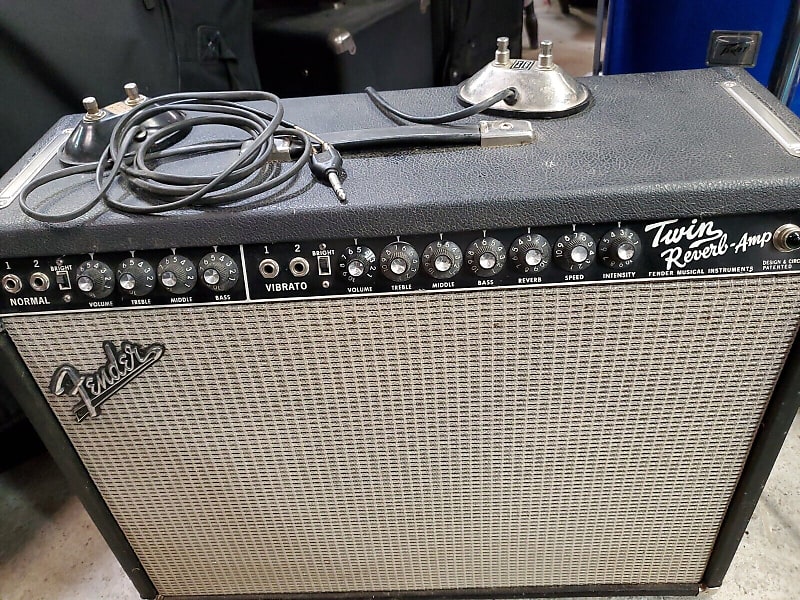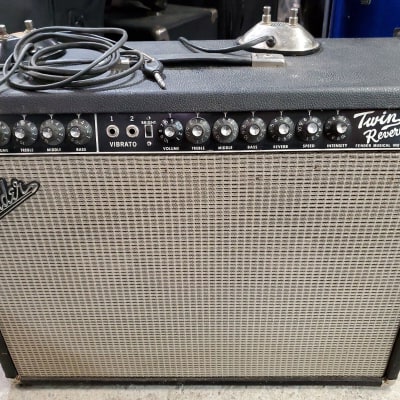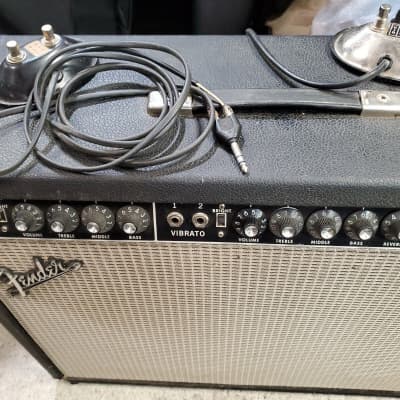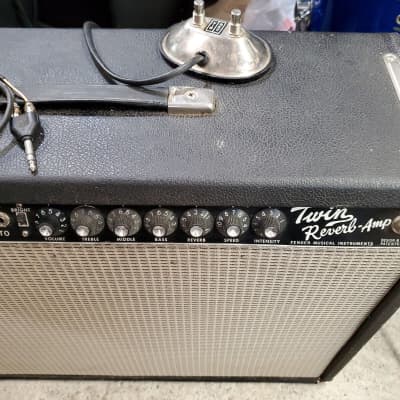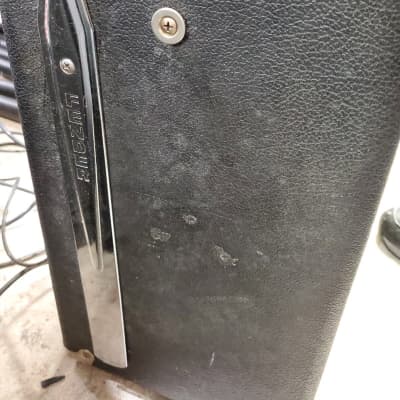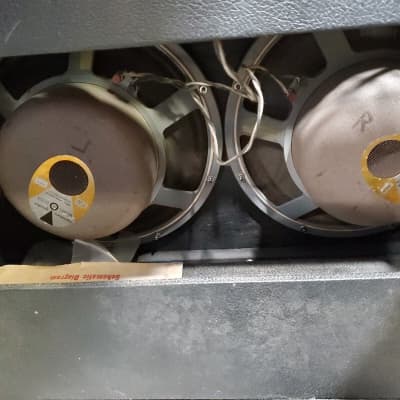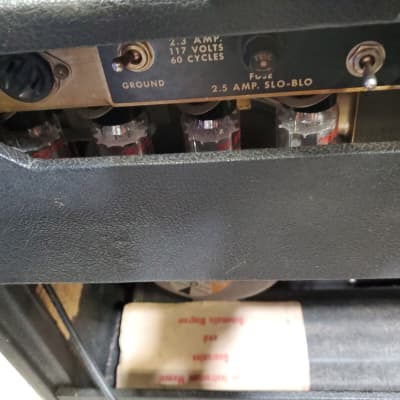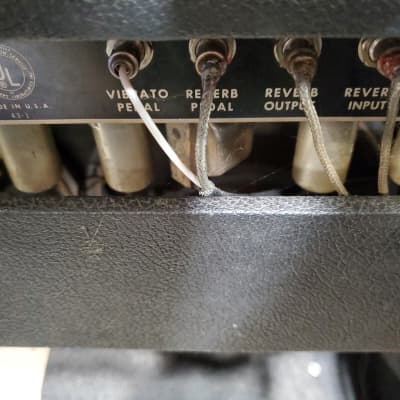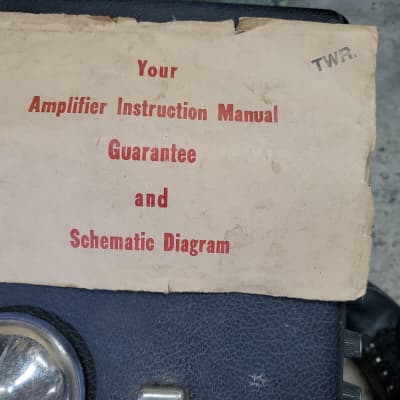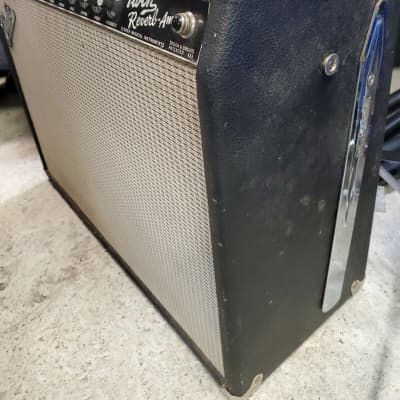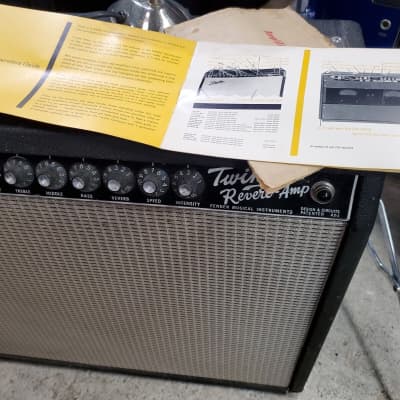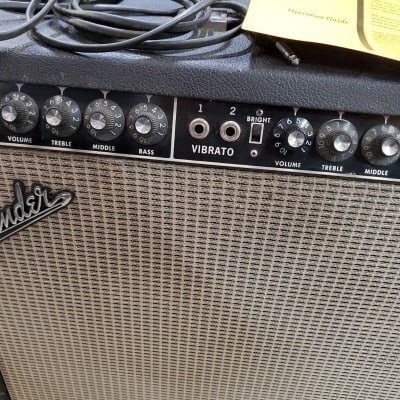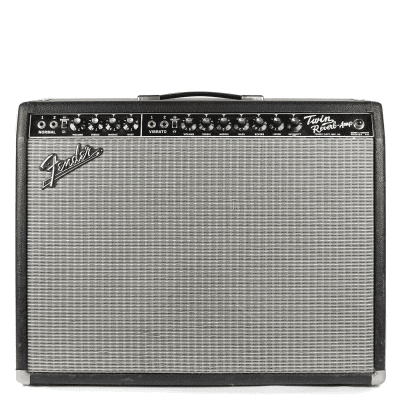Vintage 1965 Fender Twin Reverb 2-Channel 85-Watt 2x12" JBL D120s Tube Amp vibrato/reverb foot switch.
Original vintage JBL D120 speakers and original vintage (and modern) Vibrato Reverb footswitch
The original UNGROUNDED power cord comes with the amp (and can be re-attached and used again...not recommended) but has been switched to a modern GROUNDED plug for safety.
This is the definitive "blackface" model, year and tone.
"...
PRISTINE CLEANS. AGGRESSIVE OVERDRIVE. THE FENDER TWIN STORY.
Take a dive into the history of one of Fender's timeless amps that became the sound of pure rock and roll.
Along with the Bassman, there is perhaps no other Fender guitar amp as enduring and revered as the venerable Twin. It has been universally hailed as one of the all-time great guitar amps ever since it was introduced in summer 1952; prized across genres for its loud, clean tone.
Like the Bassman, which preceded it by mere months, the Twin was unveiled before it had even been named, and its design included some significant firsts. Although it was introduced at the 1952 NAMM show only as Fender’s new “Hi Fidelity” guitar amp, it was, as author Tom Wheeler notes in The Soul of Tone: Celebrating 60 Years of Fender Amps, “a milestone."
First, although still tweed-covered, it looked different from any previous Fender amp. Fender was phasing out the “TV panel” design introduced in summer 1948 in favor of a more streamlined design in which the grille, no longer recessed, ran from side to side to the inside edges of the cabinet, with wide panels running across the top and bottom of the face. Thus, the new “Hi Fidelity” amp was the first “wide-panel” Fender amp; a design that would soon be adopted for all previous TV panel models.
Second, in terms of speaker area, it was bigger than any previous model. The “Hi Fidelity” amp was only the second dual-speaker Fender model, after the 2×10-inch Dual Professional (later Super) of 1947, but the combined 24-inche cone diameter of its two heavy-duty 12-inch Jensen speakers made it the largest Fender offered.
Third, it was more powerful (25 watts) and it had more sophisticated tone controls than any of its predecessors. It was, for example, the first Fender amp with separate bass and treble controls rather than a single roll-off tone control; a development that the company called “the latest in electronic advances." Further, it had two volume knobs (bright and normal).
This original version of the amp, model 5C8, was advertised very early on as the “Twin 12 Amplifier” and “Twin 12 Artist’s Model Amp” before Fender settled on a permanent name, the Twin-Amp, which was soon widely known in even shorter form as the Twin.
In true Fender form, revisions and improvements were instituted almost immediately. The second wide-panel version, mid-1954’s model 5D8, had different preamp, phase inverter and rectifier tubes, and boasted a tonally versatile advance in the form of a presence control and tone controls that were more responsive.
Major cosmetic and electronic changes ensued in 1955. Wide panel amps were only around for a couple years before Fender adopted the narrow panel cabinet style, which dispensed with the wide panels across the top and bottom of the amp face in favor of a larger grille made of a more modern fabric. This new Twin, model 5E8, was given a slightly smaller cabinet with the speakers at the lower right and top left corners rather than simply side by side.
The biggest changes were electronic, though. Refined circuitry boosted model 5E8 to 50 watts, with even more power introduced in 1956 and through the remainder of the 1950s in subsequent variations—the short-lived model 5F8 (1957) and the vaunted model 5F8-A of 1958-1959 were 80-watt and 100-watt Twins that pushed their Jensen P12-N speakers to (and often past) the brink. These amps had six knobs: normal volume, bright volume, bass, treble, presence and new “middle", and by 1958 their speakers were once again in a straight side-by-side configuration in a larger cabinet.
It’s hard to overstate the significance of the powerful E and F series Twins of 1955-1959. Describing them in The Soul of Tone, Wheeler notes that they and the other narrow-panel amps “offered technological advancements, signature tones, handsome appearance, ruggedness, and a something-for-every-player variety that would take Fender to the pinnacle of amplifier manufacturing.”
Like most other Fender amps, the Twin exchanged its tweed covering for Tolex in 1960, but only after it seemingly “disappeared” for a few months starting in January of that year. Although it ruled the Fender guitar amp line in the ’50s, the Twin, as authors John Teagle and John Sprung note in Fender Amps: The First Fifty Years, “ended up in limbo for a short period” as Fender introduced a new top-of-the-line amp, the Vibrasonic, and perfected its piggyback Showman prototypes (unlike many of its stablemates, the Twin never evolved into a piggyback model).
The Twin resurfaced in June 1960, dressed in brown Tolex and having volume, bass, treble, speed, intensity and presence controls. This was a short-lived version, however; quickly superseded in 1961 by the white Tolex/maroon grille cloth Twin with a control layout of volume, treble and bass (normal channel) and volume, treble, bass, speed and intensity (vibrato channel). The 1962 model received wheat grille cloth late in the year, and a black metal-reinforced handle replaced the brown handle in early 1963.
These blonde Twin amps of the early 1960s (models 6G8 and 6G8-A) occupied the top of Fender’s combo line and were formidable in their own right. Indeed, as Wheeler notes in The Soul of Tone, they had “great looks, a whopping ten tubes, plenty of power, tilt-back legs, gobs of kingpin mojo and one of the best tremolos of all time.”
Then came a watershed: the “blackface” reverb-equipped amps of 1963. It might not be possible to say more in praise of the black Tolex-covered Twin Reverb of 1963-67 than has already been said; Teagle and Sprung describe it as “possibly the quintessential combo amp,” and a model that “speaks with a deep, rich voice, sonorous and confident.”
Introduced in late summer 1963, the 85-watt black Twin Reverb had classic silver-sparkle grille cloth, a raised Fender logo and redesigned dual-channel circuitry (normal and vibrato) with bright switches for both channels instead of a presence control. The “middle” tone control returned on the amp, which had numbered and skirted black knobs and a black control panel (hence the term “blackface”). It too is frequently shortened to “Fender Twin” or simply “Twin", although it shouldn’t be confused with the tweed and blonde-era Twins, which had vastly different circuits and no reverb.
The original mid-’60s era of the blackface Twin reverb encompasses Fender’s acquisition by CBS, which took effect in January 1965. Generally speaking, Twins that have “Fender Electric Instruments” on their black faceplates were made before the CBS takeover; those that have “Fender Musical Instruments” on their black faceplates date to after the takeover (but not without exceptions; pre-CBS panels were used up through fall 1965).
The blackface Twin Reverb of 1963 to summer 1967 was followed in fall 1967 by the silverface Twin reverb—a member of the first group of post-Leo Fender amps. It had a brushed aluminum control panel, aluminum trim, blue-sparkle grille cloth and a slightly shallower cabinet. Its circuitry remained the same as its blackface predecessor for a short period until a bias balance control was introduced in mid-1968 (a questionable feature abandoned by late 1969). Further, the silverface Twin was boosted to 100 watts.
The mid-’60s also saw Fender’s first ill-fated foray into solid-state amps. The first three appeared in summer 1966 and included a 100-watt transistorized Twin Reverb with dual 12-inch speakers mounted one above the other. It also included the oddball “Style” control, a three-position knob that controlled “Pop", “Normal" and “CW/RR” settings. No need here to rehash the well-documented failure of the experiment; suffice it to say that the solid-state Twin was retired in 1969 and the entire series was abandoned in 1971.
A master volume control first appeared on the Twin Reverb in 1972. The Fender logo lost its tail by 1976, around which time pull-boost and hum balance controls were added. Power was upped to 135 watts in 1977 with the use of ultra-linear output transformers, but by the late 1970s general quality was seen to have suffered across the amp line.
The blackface look soon returned, becoming an option in 1980 and standard in 1982, which was the final year of production for the traditional Twin Reverb.
The 105-watt Twin Reverb II of late 1982-86 and the 100-watt red-knob (later black-knob) version known as “The Twin” of 1987-94 were loaded with features but bore little more than the most superficial resemblance to their ancestors. The latter was a very popular model and is doubly significant as the first Twin model to appear after CBS sold Fender in early 1985.
As Fender fought its way back to success throughout the latter 1980s and into the 1990s, it returned to tradition with an acclaimed and popular series of reissue amps. Remarkably similar to the original in both appearance and circuitry, the 85-watt blackface Vintage Reissue series '65 Twin Reverb Reissue Ilt n (PLEASE NOTE: THE AMP FOR SALE IS NOT A REISSUE!!!) vintage form, this time with modern function. Highly successful, it remains in the Fender amp line today and was merely the first of several modern-era amps bearing the legendary name; these include the '68 Custom Twin Reverb (2013) and '57

